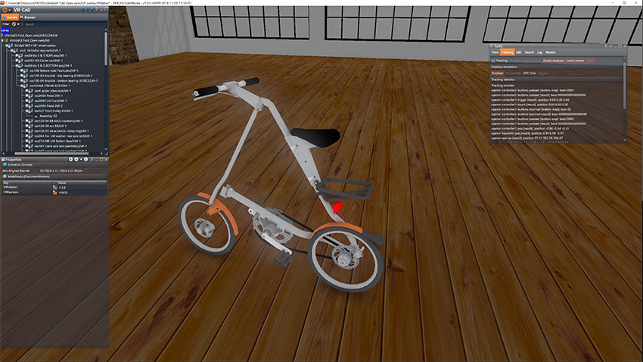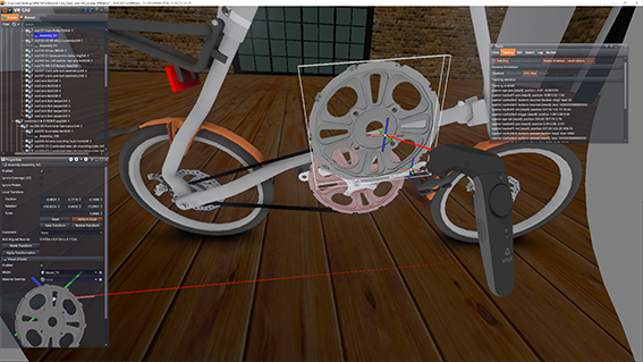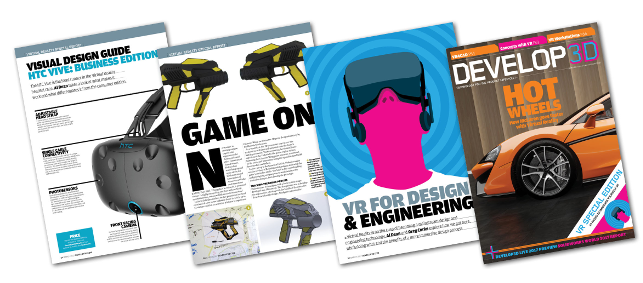Virtalis is a name that has been associated with Virtual Reality since its inception.
The company has built a reputation for delivering not only full service installation and commissioning of some of the most advanced immersive design centres in the world, but also as a provider of the software required to drive them (with its Visionary Render system).
With that background, the company is perfectly positioned to take advantage of lower cost HMDs now available and has recently launched its first release.
The goal with VR4CAD is to provide the quickest and easiest entry point into the VR world for CAD users. It has done this by simplifying not only the user interaction with the software, but also the pricing model, so let’s look at the software first, then talk turkey.

Fig.1 VR4CAD lets you import data from a variety of sources, overlay a scene and get to work Data courtesy of Mark Sanders Design
Model set-up
VR4CAD is built around the concept of the designer or engineer having their CAD models ready and wanting to explore them in a virtual world. The system is centred around the fact that you typically have one or two data formats that you need to read. As such, it’s sold on a “VR4CAD for CAD System X” basis. If you run SolidWorks, you buy and use VR4CAD for SolidWorks. If you run NX , then it’s VR4CAD for NX.
There are a number of different options covering all of the main bases, including SolidWorks, Inventor, Catia and NX. There are then options if you want to focus your workfl ow on JT, CreoView/ProductView or STEP data as well.
Once you’ve got the system installed and licenced then you’re ready to start preparing your data for VR design review and evaluation.
It’s a simple case of opening up the assembly file in VR4CAD. This uses a set of industry standard translators to take your geometry and convert it into the VR4CAD platform. Opening the file kicks off the process and depending on the complexity of your data, you’ll soon be presented with a blank screen with your model at the centre of it.
While the translators will attempt to map your materials and ensure that the model is in the correct orientation, you might find something needs adjusting. Whether that’s to account for position (in terms of rotation) or material definitions. You can quickly adapt the existing definitions or drag and drop your own from the library.
Once the basics are done, you then work through the process of setting up the context. If you want to keep things simple, you can just have the model, but with a few clicks, you can also overlay a scene.
There are a number of pre-baked options to choose from, ranging from a studio (as shown in Figure 1) to a factory floor, to a workshop and a simple floor plan and sky arrangement.
If you want to add additional lighting into the scene, you can do so, choosing from the usual omni-directional, spot, area or ambient lights. You also have control over shadows and other matters (such as ambient occlusion), so you can really dial things in.
Adding viewpoints and cameras
One point to consider here is that you might want to have your review sessions focus on specific parts or want to add in preset views of the product at hand.
To assist with this, you can define Viewpoints. These allow you to move the model into position (or rather, the view of the model) and define a Viewpoint. These can then be recalled during the session at any point.
Kick off your VR session
When all of the set-up work is done, you’re then ready to start a VR session. VR4CAD automatically detects the hardware you have in place. It works with the HTC Vive, the Oculus Rift and the ZSpace desktop VR device.
Bring up the tools menu, find ‘tracking’ and choose your option.
This will then switch on the headset and push the data to it. On screen, you’ll also have a pretty good representation of what’s happening (figure 2 shows this), so anyone else in the room can follow along on a monitor or projector.
When you put on the headset, you’ll find yourself in the environment you’ve created. The controllers act as manipulators, allowing you to highlight parts within the assembly, but also to move yourself around the scene, which is really useful for large assemblies.
We tried VR4CAD with a number of datasets from a variety of systems, from the bike you see here, to a full scale mock up of a submarine (read from NX data), to smaller more complex (geometrically speaking) engine models. The geometry loaded perfectly and navigation was a breeze.

Fig.2 VR4CA’s snap back mode lets you pull parts out of an assembly, inspect, even scale them, then snap them back into position Data courtesy of Mark Sanders Design
Not just a viewer
So over and above viewing and exploring your model, what else does VR4CAD allow you to do? One of the most interesting aspects is the ability to grab parts from the product and inspect them more closely. You indicate the part you want, hit the trigger with your controller and grab the part to pull it out. This can be inspected more closely and even scaled using the two controllers at once.
Once you’re finished with it (and assuming you have Object Snap Back enabled in the settings), you move the part close to its original position, it flashes red and when you release the part, it pops back into position.
All through the process, you can make annotations on the model, add section planes and more. The user interface hides many of the advanced tools, but being able to bring it up in the VR environment makes it a lot more usable.
In conclusion
Virtalis’s move into lower-cost VR applications makes huge sense, it has been working with VR for decades and has a rich set of experience in terms of both development and what users want.
VR4CAD is always going to be a younger, less capable system than its older sibling, Visionary Render, but that’s to be expected at this price point. The introductory price (valid until May 2017) is £999. After that, the price rises to £2,000.
This is for a single licence, importing one data format, for a year. Any updates to the software in that time are included and there’s also the potential for a discount for multiple seats and/or multiple fi le formats.
In terms of hardware requirements, your workstation should have at least 8GB Ram, 1GB Disk space and 4 processor cores, such as the Intel Xeon / Core i5 / or Core i7. For driving your VR headset, you’re going to need a NVIDIA QUADRO card, either the M or K series with minimum 1GB graphics memory.
We ran it on two VR ready machines, the HP840 and a Lenovo ThinkPad P71 and it performed well on both. That’s what you’d expect from a company with such a rich history in the field.
In terms of usability, it is just as you would imagine. VR4CAD is definitely focussed on engineering evaluation and interaction, rather than hyper realistic aesthetic and styling visualisation. The tools in the system to help you explore your product models in a more immersive manner are all there and work well.
I particularly like the ability to grab a part, pull it out of an assembly, scale it if needs be, then snap it back into place.
If there was a criticism, it would be that it could have a more intuitive, controller mechanism for controlling some of the options. Popping up the complete menu in VR works, but it could be made more simple — and it’s pretty hard to work with if you’re running a 4K monitor in the background.
That said, it all works, reads your native geometry nicely, maintains assembly structure and colour/materials where possible, but if you want to dial things in, you can dig in and do it.
When you consider the nature of VR use in design and engineering, we’re not yet at the point where creation in such an environment makes sense (for many reasons), but where it can thrive is in design review, evaluation and presentation — something traditionally reserved for the large corporates (and Virtalis’ traditional customers).
By stripping back some of the advanced features, streamlining the set-up and preparation process, Virtalis has done a cracking job of applying its knowledge to a product that’s aimed at and perfectly suited to a much wider audience.
This article is part of a DEVELOP3D Special Report into Virtual Reality (VR) for design, engineering and manufacturing, which takes an in-depth look at the latest developments in software and hardware and what you need to get up and running.
Everything is for a reason How McLaren Automotive unleashes VR to create faster cars with more attention to detail
Quick guide: VR enabled applications A list of what’s out there now or coming soon
Virtual Reality challenges & future Six industry thought leader’s views on the future of VR
HTC Vive: Getting up and running Our experience of working with HTC Vive and how to avoid common mistakes
Workstations & GPUs for VR A back to basics guide to buying hardware for Virtual Reality
The future of immersive engineering Virtual Reality (VR) is the current hot topic, but Augmented Reality (AR) and Mixed Reality (MR) is on its way. We take a look at where things are heading
Game on Amalgam creates game controllers for Holovis
VRED Pro 2017 & VR The latest release adds greater support for the HTC Vive and Oculus Rift tools
ESI Group IC.IDO 11 ESI’s IC.ID0 is one of the most advanced Digital Mock Up tools available. With its addition of Vive support, we take a look at what the system is capable of and how it can benefit engineering
Gravity Sketch Beta An interesting take on Modelling in Virtual Reality
Google Tiltbrush A system for VR creativity that’s both cheap and capable
Oculus Medium A good contender for design experimentation
Amari Magnetar V25 This stylish workstation has been specifically designed for VR. But despite its slimsline chassis, you can still cram in incredible processing power
Nvidia Quadro P2000/P4000 Nvidia is changing the landscape of professional 3D graphics with a new family of Pascal Quadro GPUs, including a single slot ‘VR Ready’ card.

To read all the articles, as they appeared in DEVELOP3D Magazine, you can download the March Edition here.
| Product | VR4CAD |
|---|---|
| Company name | Virtalis |
| Price | £999 pa (see text) |






